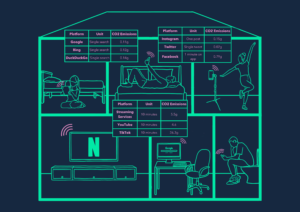What is a Carbon Footprint?
An activity’s carbon footprint measures the total amount of greenhouse gas (carbon dioxide or CO2) produced directly or indirectly from engaging in that activity.
We’re used to thinking about carbon footprint in terms of tangible, real-life activities, such as taking a long-haul flight or commuting to work via car instead of a train.
However, our online activity also produces a carbon footprint. Whenever you search for something on Google or scroll through videos on TikTok, these activities produce greenhouse gases. For a more sustainable future, it is up to us to do our bit to lower carbon emissions wherever possible, even when we are online.
Carbon Footprint of Search
It feels almost an understatement to say that Google search is one of the most widely used services on the internet. To many people, Google IS the internet.
However, with the increasing global awareness of climate change, questions have been raised about the carbon footprint of the estimated 8.5 billion Google searches that take place every day.
Google has pledged that by 2025, its search engine will be carbon neutral as part of its company-wide commitment to sustainability.
| Platform | Unit | CO2 Emissions |
| Single search | 0.11g | |
| Bing | Single search | 0.12g |
| DuckDuckGo | Single search | 0.14g |
Carbon Footprint of Streaming
As of 2023, Netflix has over 230 million users, TikTik has over 1 billion, but leading the way is Youtube, with over 2.6 billion users worldwide. If we’re watching something, there is a significant chance we’re watching it online, which comes with a major environmental impact.
| Platform | Unit | CO2 Emissions |
| Streaming Services | 10 minutes | 5.5g |
| YouTube | 10 minutes | 4.6 |
| TikTok | 10 minutes | 26.3g |
Carbon Footprint of Social
Twitter has around 450 million monthly active users, Instagram 2.35 billion and Facebook a staggering 2.91 billion. The carbon footprint of using these platforms might seem low, but looking at the number of active users, it paints a very different story.
| Platform | Unit | CO2 Emissions |
| One post | 0.15g | |
| Single tweet | 0.02g | |
| 1 minute on app | 0.79g |
How Do Digital Activities Stack up Against Everyday Ones?
The most obvious comparison is traditional (digital) TV versus online streaming platforms like Netflix.
Much is made of the harm streaming does to the planet; stats bear this out.
Watching ten minutes of TV emits 3.6g of CO2 into the atmosphere. Streaming services emit almost double that amount (5.5g) in the same time period.
Say you watch a movie that lasts 2 hours – streaming will emit 66g of C02, but watching it on TV will only produce 44g for the same movie.
| Activity | Unit | CO2 Emissions |
| Digital TV | 10 Minutes | 3.6g |
| Kettle | 500mls of water | 6.97g |
| Fridge freezer | 24 hours a day | 243.8g |
| Washing machine | 40°C wash | 700g |
| Microwave oven | Average microwave meal (6 minutes) | 406.3g |
| Electric oven | Average family meal (45 minutes) | 674g |
The most obvious comparison is traditional (digital) TV versus online streaming platforms like Netflix.
Much is made of the harm streaming does to the planet; stats bear this out.
Watching ten minutes of TV emits 3.6g of CO2 into the atmosphere. Streaming services emit almost double that amount (5.5g) in the same time period.
Say you watch a movie that lasts 2 hours – streaming will emit 66g of C02, but watching it on TV will only produce 44g for the same movie.
How can individual users of the internet minimise the carbon footprint of their online activities?
Choose Energy-efficient Devices: by ensuring your laptop, tablet, or smartphone is energy efficient, you can reduce the amount of energy used during everyday browsing.
Adjusting Device Settings: you can ensure you are using your devices in the most energy efficient way by lowering your screen’s brightness.
Digital declutter: Over time, our natural accumulation of unused files, electronic junk mail and saved screenshots can consume significant amounts of storage space and energy. Have a digital declutter by deleting your old emails and unused files. Not only will this help free up your device’s storage space, it will also reduce the energy required for data storage, making you feel less stressed every time you look at your phone.
Support Sustainable Sites: Look for websites, apps, and social media platforms that promote environmentally sustainable practices, such as renewable energy, and carbon neutrality.
How can e-commerce leaders minimise the carbon footprint of their websites?
Choose Sustainable Hosting: Switch to web hosting services that use renewable energy sources, such as wind or solar power, to reduce their carbon footprint.
Optimise Page Load Speed: Slow-loading websites frustrate your customers and waste energy. Optimising speed can reduce the amount of energy consumed by your customers and improve overall user experience, a win-win.
Website Design: The design of a website can have a significant impact on its carbon footprint. Minimise the use of large images, videos, and animations that require high bandwidth and consume more energy.
Use eco-friendly packaging: Not strictly a sustainable website hack; however, using eco-friendly packaging materials such as biodegradable or paper instead of plastic where possible is a good move. Make sure you inform customers of this on page.
Methodology
We collected data from various sources (Ofcom, Greenspector, and Envirotec Magazine) on the CO2 emissions of social media platforms, streaming services, and search engines for a set period of time and based on what we deemed standard usage for a person.
We also collected data from various sources (Circular Ecolog, Earth 911, The Guardian, and Ransom Spares) on everyday household devices carbon emissions for comparison- using the same set period of time and standard usage for an individual activity.

